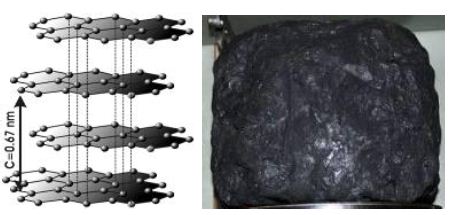Graphite (the “lead” inside pencils) is another allotrope of carbon. Each carbon atom is joined by strong covalent bonds to three others, forming sheets of atoms arranged in hexagon patterns. There are only weak London forces between the layers.

Properties of graphite
The strong covalent bonds between the atoms give graphite a very high melting point of 3600°C. The bonds between the layers are longer and weaker than the other bonds. This makes graphite less dense than diamond.
The strong bonds within the layers make graphite very strong in the direction perpendicular to the layers. The weak bonds between the layers mean that graphite can be split easily in the direction parallel to the layers. The graphite layers can also slide over each other easily, and break off. This is what happens when a pencil is rubbed over the paper, leaving a mark. The slippery nature of graphite also makes it suitable for use as a lubricant in engine oils.
Conductivity of graphite
While three electrons from each carbon are used in covalent bonds, the fourth electron is delocalized over all the atoms in its layer. These free electrons mean that graphite will conduct electricity and heat. The conductivity parallel to the layers is much greater than in a perpendicular direction. Graphite is often used as one of the terminals in batteries.










